Analysing a Sustainable Business
VerifiedAdded on 2023/06/03
|12
|2912
|344
AI Summary
This report discusses various approaches to sustainable development and their implementation in Hertz's car rental business. The circular economy and balanced scorecard approaches are compared and evaluated for their effectiveness in achieving sustainability goals.
Contribute Materials
Your contribution can guide someone’s learning journey. Share your
documents today.
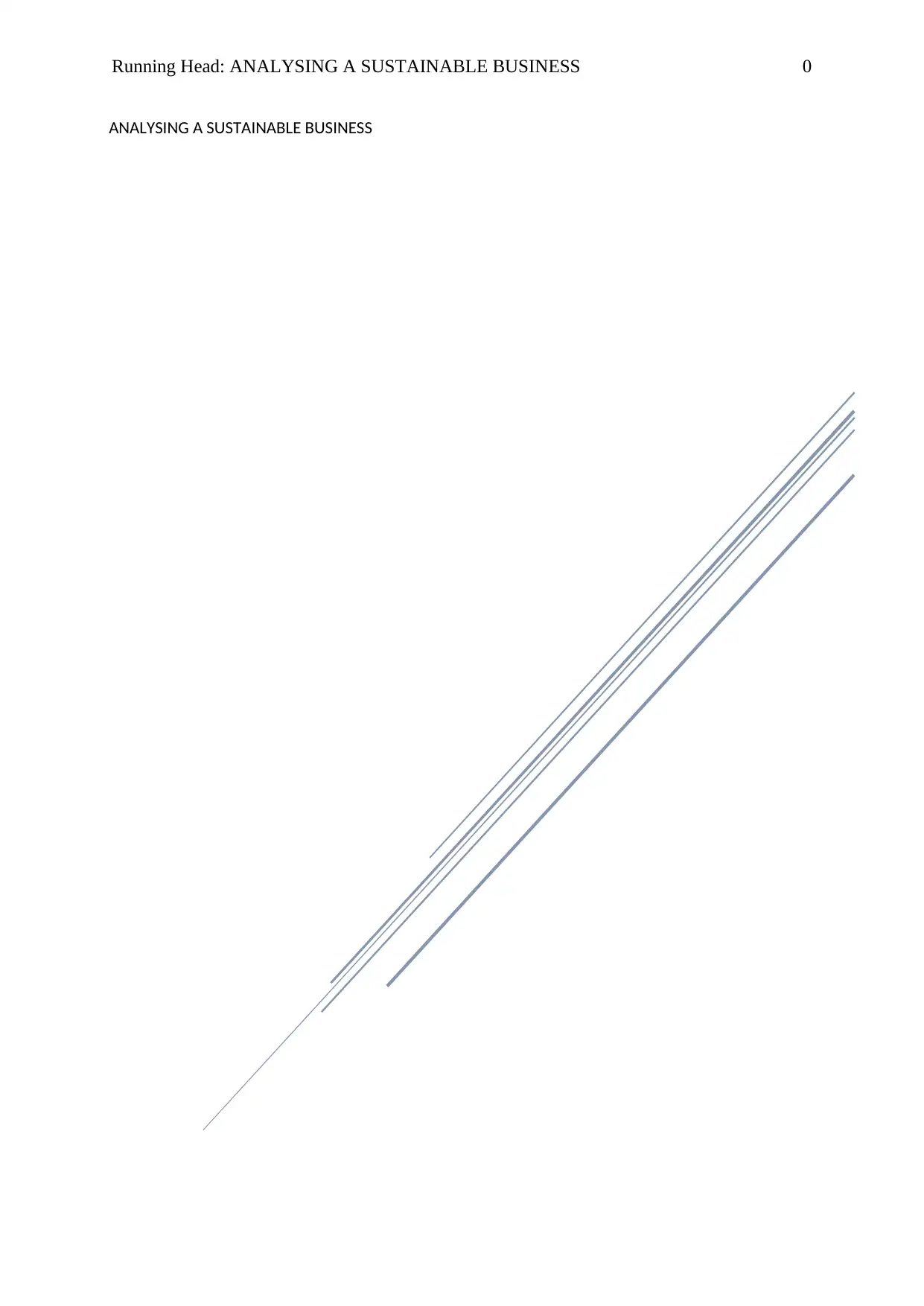
Running Head: ANALYSING A SUSTAINABLE BUSINESS 0
ANALYSING A SUSTAINABLE BUSINESS
ANALYSING A SUSTAINABLE BUSINESS
Secure Best Marks with AI Grader
Need help grading? Try our AI Grader for instant feedback on your assignments.
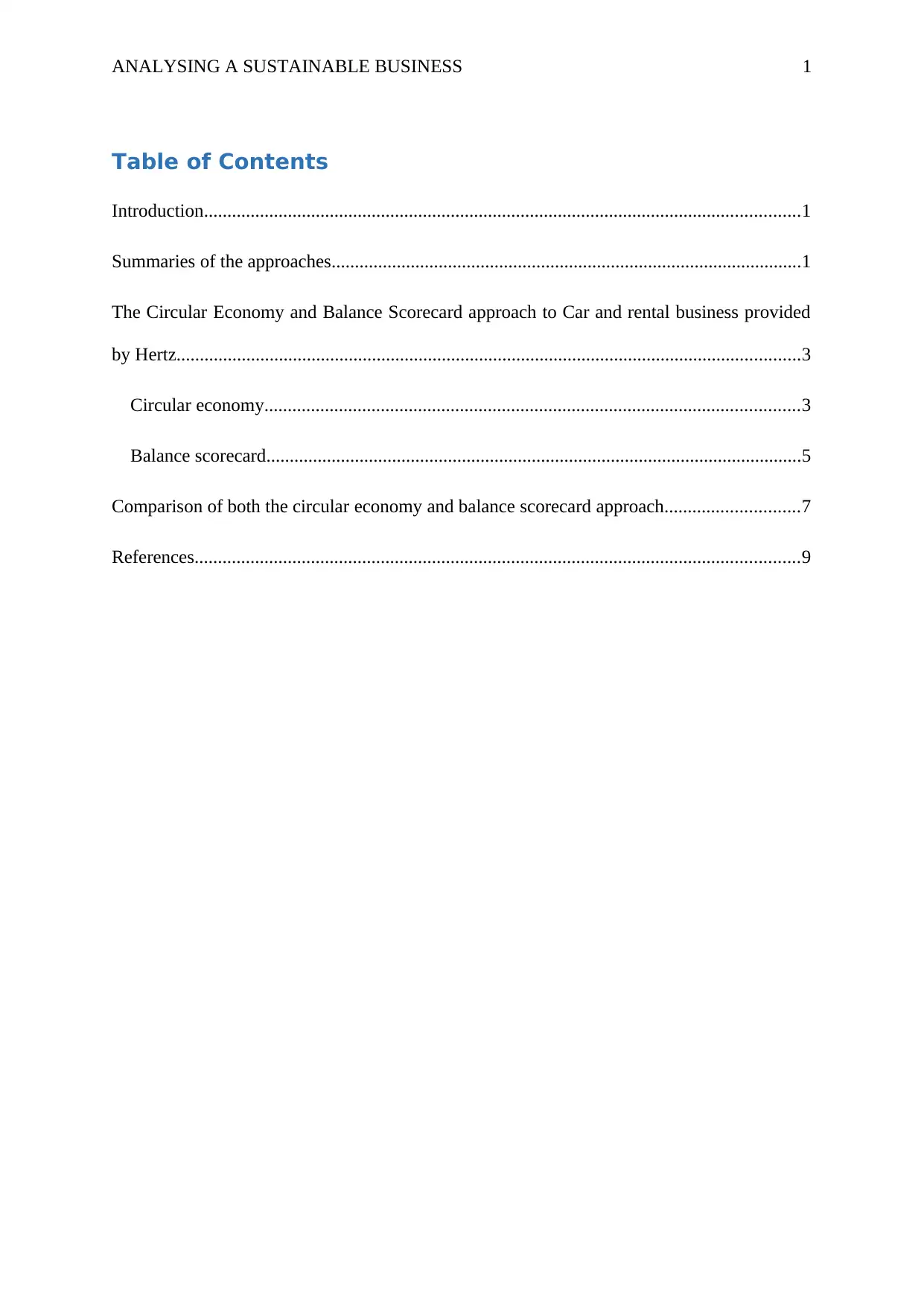
ANALYSING A SUSTAINABLE BUSINESS 1
Table of Contents
Introduction................................................................................................................................1
Summaries of the approaches.....................................................................................................1
The Circular Economy and Balance Scorecard approach to Car and rental business provided
by Hertz......................................................................................................................................3
Circular economy...................................................................................................................3
Balance scorecard...................................................................................................................5
Comparison of both the circular economy and balance scorecard approach.............................7
References..................................................................................................................................9
Table of Contents
Introduction................................................................................................................................1
Summaries of the approaches.....................................................................................................1
The Circular Economy and Balance Scorecard approach to Car and rental business provided
by Hertz......................................................................................................................................3
Circular economy...................................................................................................................3
Balance scorecard...................................................................................................................5
Comparison of both the circular economy and balance scorecard approach.............................7
References..................................................................................................................................9
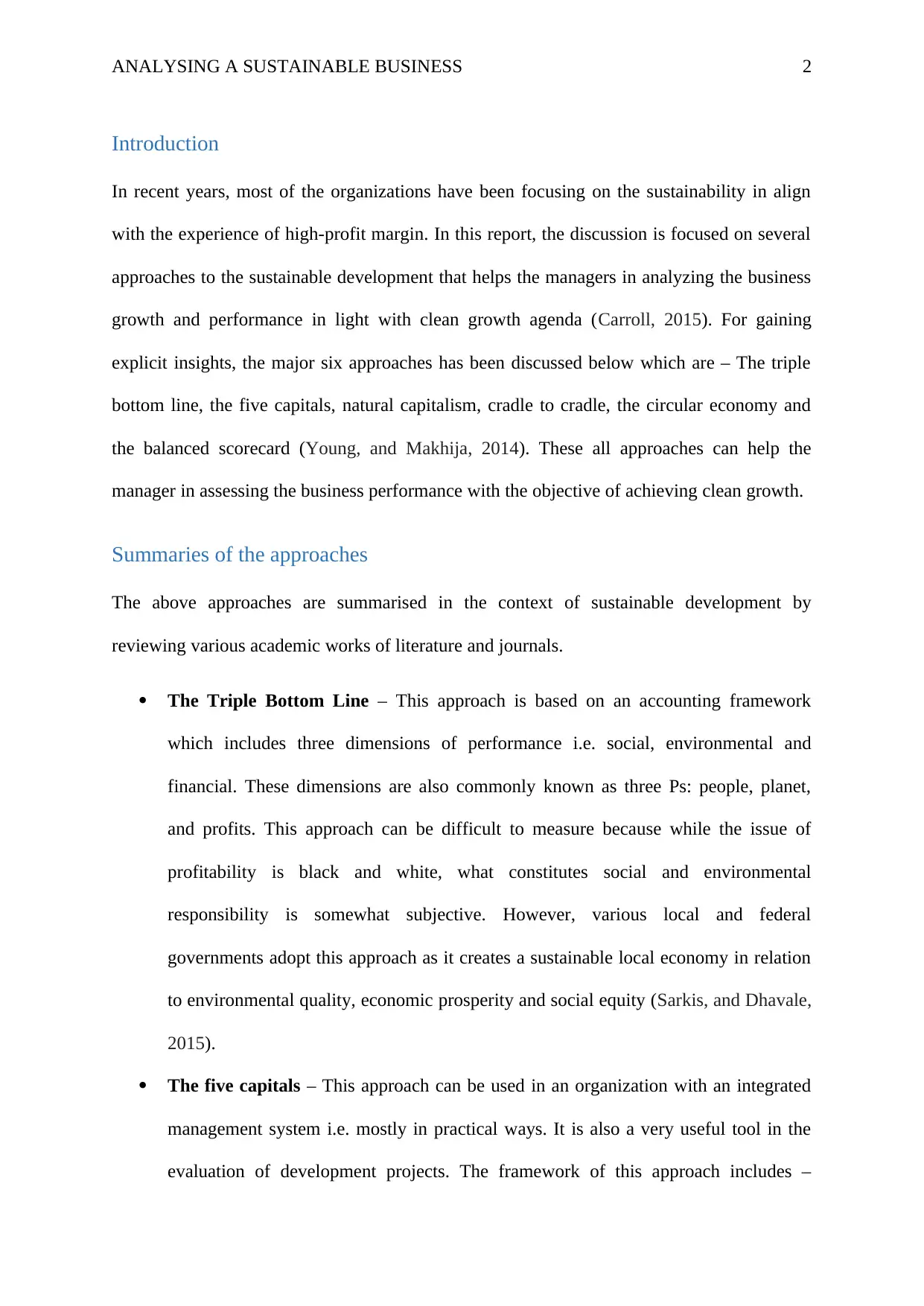
ANALYSING A SUSTAINABLE BUSINESS 2
Introduction
In recent years, most of the organizations have been focusing on the sustainability in align
with the experience of high-profit margin. In this report, the discussion is focused on several
approaches to the sustainable development that helps the managers in analyzing the business
growth and performance in light with clean growth agenda (Carroll, 2015). For gaining
explicit insights, the major six approaches has been discussed below which are – The triple
bottom line, the five capitals, natural capitalism, cradle to cradle, the circular economy and
the balanced scorecard (Young, and Makhija, 2014). These all approaches can help the
manager in assessing the business performance with the objective of achieving clean growth.
Summaries of the approaches
The above approaches are summarised in the context of sustainable development by
reviewing various academic works of literature and journals.
The Triple Bottom Line – This approach is based on an accounting framework
which includes three dimensions of performance i.e. social, environmental and
financial. These dimensions are also commonly known as three Ps: people, planet,
and profits. This approach can be difficult to measure because while the issue of
profitability is black and white, what constitutes social and environmental
responsibility is somewhat subjective. However, various local and federal
governments adopt this approach as it creates a sustainable local economy in relation
to environmental quality, economic prosperity and social equity (Sarkis, and Dhavale,
2015).
The five capitals – This approach can be used in an organization with an integrated
management system i.e. mostly in practical ways. It is also a very useful tool in the
evaluation of development projects. The framework of this approach includes –
Introduction
In recent years, most of the organizations have been focusing on the sustainability in align
with the experience of high-profit margin. In this report, the discussion is focused on several
approaches to the sustainable development that helps the managers in analyzing the business
growth and performance in light with clean growth agenda (Carroll, 2015). For gaining
explicit insights, the major six approaches has been discussed below which are – The triple
bottom line, the five capitals, natural capitalism, cradle to cradle, the circular economy and
the balanced scorecard (Young, and Makhija, 2014). These all approaches can help the
manager in assessing the business performance with the objective of achieving clean growth.
Summaries of the approaches
The above approaches are summarised in the context of sustainable development by
reviewing various academic works of literature and journals.
The Triple Bottom Line – This approach is based on an accounting framework
which includes three dimensions of performance i.e. social, environmental and
financial. These dimensions are also commonly known as three Ps: people, planet,
and profits. This approach can be difficult to measure because while the issue of
profitability is black and white, what constitutes social and environmental
responsibility is somewhat subjective. However, various local and federal
governments adopt this approach as it creates a sustainable local economy in relation
to environmental quality, economic prosperity and social equity (Sarkis, and Dhavale,
2015).
The five capitals – This approach can be used in an organization with an integrated
management system i.e. mostly in practical ways. It is also a very useful tool in the
evaluation of development projects. The framework of this approach includes –
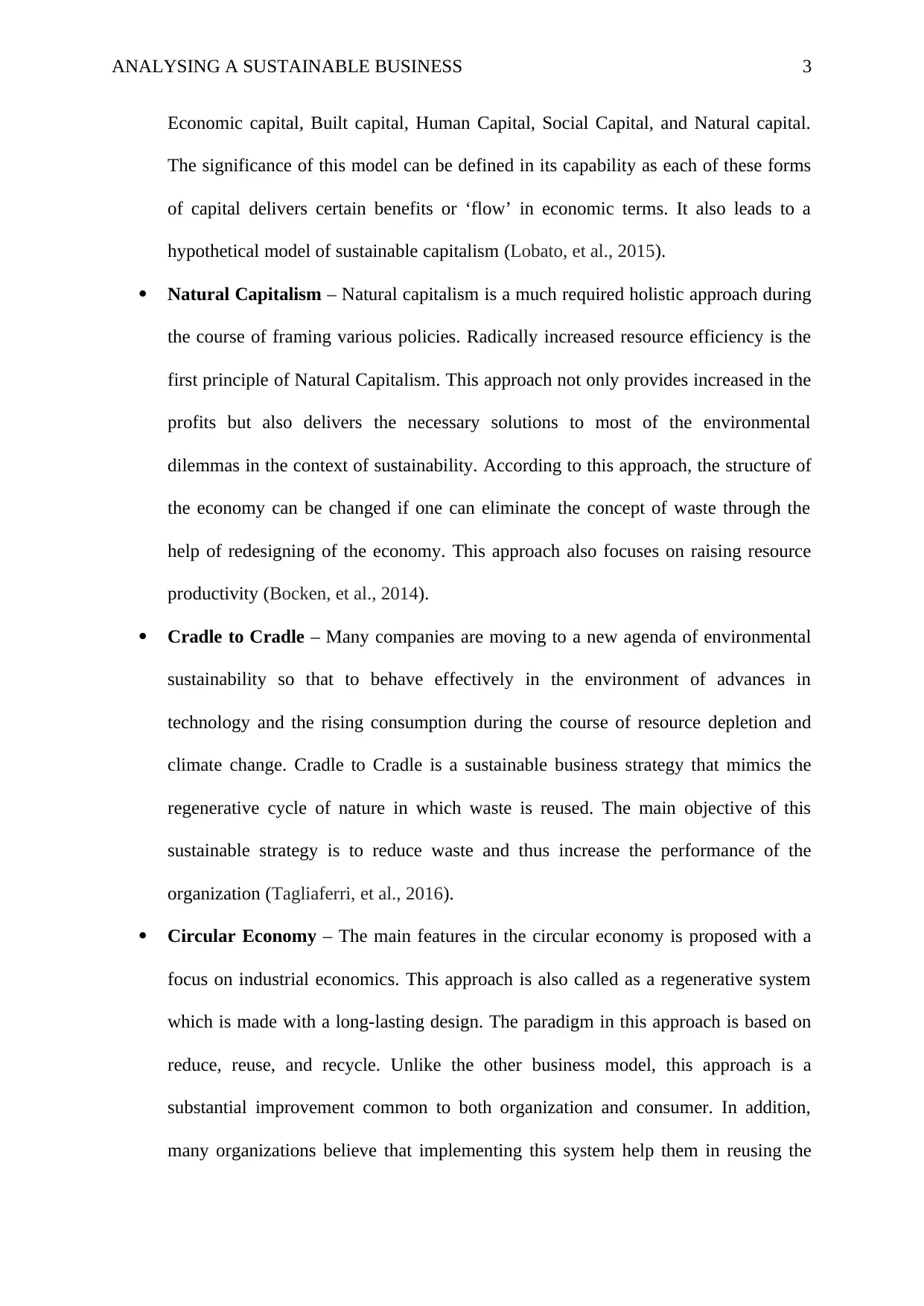
ANALYSING A SUSTAINABLE BUSINESS 3
Economic capital, Built capital, Human Capital, Social Capital, and Natural capital.
The significance of this model can be defined in its capability as each of these forms
of capital delivers certain benefits or ‘flow’ in economic terms. It also leads to a
hypothetical model of sustainable capitalism (Lobato, et al., 2015).
Natural Capitalism – Natural capitalism is a much required holistic approach during
the course of framing various policies. Radically increased resource efficiency is the
first principle of Natural Capitalism. This approach not only provides increased in the
profits but also delivers the necessary solutions to most of the environmental
dilemmas in the context of sustainability. According to this approach, the structure of
the economy can be changed if one can eliminate the concept of waste through the
help of redesigning of the economy. This approach also focuses on raising resource
productivity (Bocken, et al., 2014).
Cradle to Cradle – Many companies are moving to a new agenda of environmental
sustainability so that to behave effectively in the environment of advances in
technology and the rising consumption during the course of resource depletion and
climate change. Cradle to Cradle is a sustainable business strategy that mimics the
regenerative cycle of nature in which waste is reused. The main objective of this
sustainable strategy is to reduce waste and thus increase the performance of the
organization (Tagliaferri, et al., 2016).
Circular Economy – The main features in the circular economy is proposed with a
focus on industrial economics. This approach is also called as a regenerative system
which is made with a long-lasting design. The paradigm in this approach is based on
reduce, reuse, and recycle. Unlike the other business model, this approach is a
substantial improvement common to both organization and consumer. In addition,
many organizations believe that implementing this system help them in reusing the
Economic capital, Built capital, Human Capital, Social Capital, and Natural capital.
The significance of this model can be defined in its capability as each of these forms
of capital delivers certain benefits or ‘flow’ in economic terms. It also leads to a
hypothetical model of sustainable capitalism (Lobato, et al., 2015).
Natural Capitalism – Natural capitalism is a much required holistic approach during
the course of framing various policies. Radically increased resource efficiency is the
first principle of Natural Capitalism. This approach not only provides increased in the
profits but also delivers the necessary solutions to most of the environmental
dilemmas in the context of sustainability. According to this approach, the structure of
the economy can be changed if one can eliminate the concept of waste through the
help of redesigning of the economy. This approach also focuses on raising resource
productivity (Bocken, et al., 2014).
Cradle to Cradle – Many companies are moving to a new agenda of environmental
sustainability so that to behave effectively in the environment of advances in
technology and the rising consumption during the course of resource depletion and
climate change. Cradle to Cradle is a sustainable business strategy that mimics the
regenerative cycle of nature in which waste is reused. The main objective of this
sustainable strategy is to reduce waste and thus increase the performance of the
organization (Tagliaferri, et al., 2016).
Circular Economy – The main features in the circular economy is proposed with a
focus on industrial economics. This approach is also called as a regenerative system
which is made with a long-lasting design. The paradigm in this approach is based on
reduce, reuse, and recycle. Unlike the other business model, this approach is a
substantial improvement common to both organization and consumer. In addition,
many organizations believe that implementing this system help them in reusing the
Secure Best Marks with AI Grader
Need help grading? Try our AI Grader for instant feedback on your assignments.

ANALYSING A SUSTAINABLE BUSINESS 4
resources in a much cost-effective manner rather them generating them from scratch.
Moreover, the prices of products will also be reduced which impact the sales price
and the final consumers (Murray, Skene, and Haynes, 2017).
The Balance Scorecard – The Sustainability Balance Scorecard (SBSC) focused on
three different perspectives i.e. economy, ecology, and society, unlike the standard
Balance Scorecard that focuses on the implementation of the strategy on an
operational level. This new balance scorecard provides the business firm an ability to
evaluate the contribution of sustainable development to their goals. This makes the
differences to be added upon in the bottom line of the organization and thus increases
performance (Valmohammadi, and Ahmadi, 2015).
The Circular Economy and Balance Scorecard approach to Car and rental
business provided by Hertz.
Hertz is leading the international car rental industry. Being a part of service providing
industry Hertz focusses on quality and efficiency of their services. In recent years, the
company has started serving the insurance replacement and hourly rental car share service as
well. Along with rental cars, some additional services making their car rental service more
efficient are also initiated by the company. All the services provided by the company are
supporting the circular economy and balanced scorecard approach for a sustainable
development of the business (Hertz, 2018a).
Circular economy
Businesses like Hertz are becoming increasingly sophisticated to understand and implement
the corporate social responsibilities through their business model. Businesses in recent years
are implementing these corporate social sustainable principles at the core of their business
model for sustainability purpose. In this context circular economy is getting more and more
resources in a much cost-effective manner rather them generating them from scratch.
Moreover, the prices of products will also be reduced which impact the sales price
and the final consumers (Murray, Skene, and Haynes, 2017).
The Balance Scorecard – The Sustainability Balance Scorecard (SBSC) focused on
three different perspectives i.e. economy, ecology, and society, unlike the standard
Balance Scorecard that focuses on the implementation of the strategy on an
operational level. This new balance scorecard provides the business firm an ability to
evaluate the contribution of sustainable development to their goals. This makes the
differences to be added upon in the bottom line of the organization and thus increases
performance (Valmohammadi, and Ahmadi, 2015).
The Circular Economy and Balance Scorecard approach to Car and rental
business provided by Hertz.
Hertz is leading the international car rental industry. Being a part of service providing
industry Hertz focusses on quality and efficiency of their services. In recent years, the
company has started serving the insurance replacement and hourly rental car share service as
well. Along with rental cars, some additional services making their car rental service more
efficient are also initiated by the company. All the services provided by the company are
supporting the circular economy and balanced scorecard approach for a sustainable
development of the business (Hertz, 2018a).
Circular economy
Businesses like Hertz are becoming increasingly sophisticated to understand and implement
the corporate social responsibilities through their business model. Businesses in recent years
are implementing these corporate social sustainable principles at the core of their business
model for sustainability purpose. In this context circular economy is getting more and more
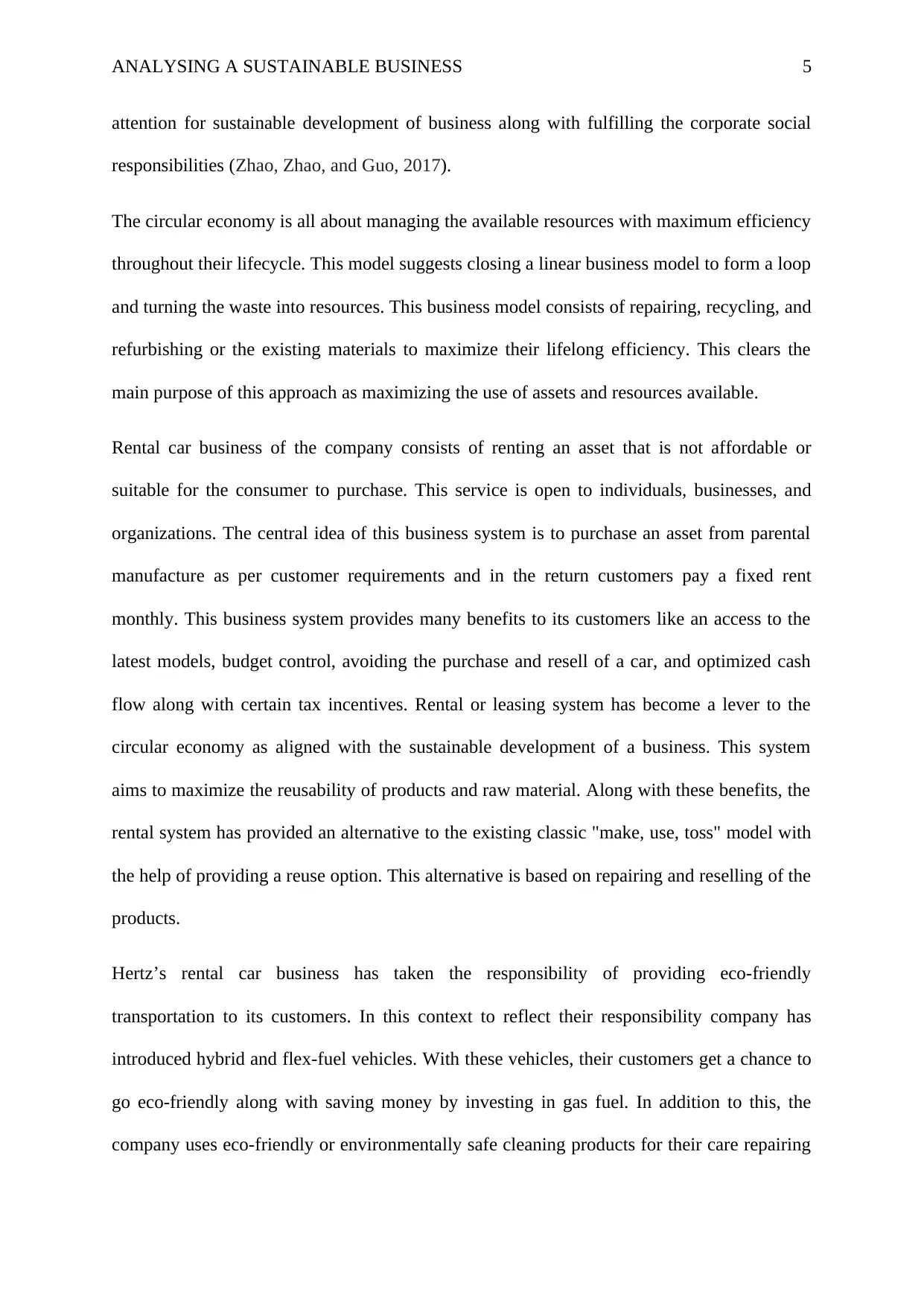
ANALYSING A SUSTAINABLE BUSINESS 5
attention for sustainable development of business along with fulfilling the corporate social
responsibilities (Zhao, Zhao, and Guo, 2017).
The circular economy is all about managing the available resources with maximum efficiency
throughout their lifecycle. This model suggests closing a linear business model to form a loop
and turning the waste into resources. This business model consists of repairing, recycling, and
refurbishing or the existing materials to maximize their lifelong efficiency. This clears the
main purpose of this approach as maximizing the use of assets and resources available.
Rental car business of the company consists of renting an asset that is not affordable or
suitable for the consumer to purchase. This service is open to individuals, businesses, and
organizations. The central idea of this business system is to purchase an asset from parental
manufacture as per customer requirements and in the return customers pay a fixed rent
monthly. This business system provides many benefits to its customers like an access to the
latest models, budget control, avoiding the purchase and resell of a car, and optimized cash
flow along with certain tax incentives. Rental or leasing system has become a lever to the
circular economy as aligned with the sustainable development of a business. This system
aims to maximize the reusability of products and raw material. Along with these benefits, the
rental system has provided an alternative to the existing classic "make, use, toss" model with
the help of providing a reuse option. This alternative is based on repairing and reselling of the
products.
Hertz’s rental car business has taken the responsibility of providing eco-friendly
transportation to its customers. In this context to reflect their responsibility company has
introduced hybrid and flex-fuel vehicles. With these vehicles, their customers get a chance to
go eco-friendly along with saving money by investing in gas fuel. In addition to this, the
company uses eco-friendly or environmentally safe cleaning products for their care repairing
attention for sustainable development of business along with fulfilling the corporate social
responsibilities (Zhao, Zhao, and Guo, 2017).
The circular economy is all about managing the available resources with maximum efficiency
throughout their lifecycle. This model suggests closing a linear business model to form a loop
and turning the waste into resources. This business model consists of repairing, recycling, and
refurbishing or the existing materials to maximize their lifelong efficiency. This clears the
main purpose of this approach as maximizing the use of assets and resources available.
Rental car business of the company consists of renting an asset that is not affordable or
suitable for the consumer to purchase. This service is open to individuals, businesses, and
organizations. The central idea of this business system is to purchase an asset from parental
manufacture as per customer requirements and in the return customers pay a fixed rent
monthly. This business system provides many benefits to its customers like an access to the
latest models, budget control, avoiding the purchase and resell of a car, and optimized cash
flow along with certain tax incentives. Rental or leasing system has become a lever to the
circular economy as aligned with the sustainable development of a business. This system
aims to maximize the reusability of products and raw material. Along with these benefits, the
rental system has provided an alternative to the existing classic "make, use, toss" model with
the help of providing a reuse option. This alternative is based on repairing and reselling of the
products.
Hertz’s rental car business has taken the responsibility of providing eco-friendly
transportation to its customers. In this context to reflect their responsibility company has
introduced hybrid and flex-fuel vehicles. With these vehicles, their customers get a chance to
go eco-friendly along with saving money by investing in gas fuel. In addition to this, the
company uses eco-friendly or environmentally safe cleaning products for their care repairing

ANALYSING A SUSTAINABLE BUSINESS 6
purpose. This business also consists of many risks related to the damage insurance for both
the customers as well as the vehicle. These risks make a significant impact on the concept of
a circular economy.
Balance scorecard
Business sustainability or corporate sustainability is often defined as managing the triple
bottom line process, a process that is used to manage the financial, environmental, and social
opportunities as well as obligations. The coordination of these social, environmental, and
financial elements is essential to ensure a responsible and ethical on-going success of the
business. The social, environmental, and financial demands of a business are considered as
three pillars of sustainability for a business. The triple line approach evolves planning,
managing and reporting of business results in three areas:
Economic: Profits, sales, jobs created, cash flow, ROI
Environmental: Impact on air, water, waste generation, energy use
Social: Community impact, human rights, product responsibility
To understand the alignment of business sustainability or corporate social responsibility with
overall business strategy, the balanced scorecard is the best option. A strategic balance
scorecard involves the firm's collaborative development to identify the connection between
efficient business processes, organizational capacity, stakeholder satisfaction, customer
values, and market and financial outcomes of the business. A balanced scorecard uses four
strategic perspectives to make a business sustainable that are financial, customer, internal
process and organizational capacity (Valmohammadi, and Ahmadi, 2015).
purpose. This business also consists of many risks related to the damage insurance for both
the customers as well as the vehicle. These risks make a significant impact on the concept of
a circular economy.
Balance scorecard
Business sustainability or corporate sustainability is often defined as managing the triple
bottom line process, a process that is used to manage the financial, environmental, and social
opportunities as well as obligations. The coordination of these social, environmental, and
financial elements is essential to ensure a responsible and ethical on-going success of the
business. The social, environmental, and financial demands of a business are considered as
three pillars of sustainability for a business. The triple line approach evolves planning,
managing and reporting of business results in three areas:
Economic: Profits, sales, jobs created, cash flow, ROI
Environmental: Impact on air, water, waste generation, energy use
Social: Community impact, human rights, product responsibility
To understand the alignment of business sustainability or corporate social responsibility with
overall business strategy, the balanced scorecard is the best option. A strategic balance
scorecard involves the firm's collaborative development to identify the connection between
efficient business processes, organizational capacity, stakeholder satisfaction, customer
values, and market and financial outcomes of the business. A balanced scorecard uses four
strategic perspectives to make a business sustainable that are financial, customer, internal
process and organizational capacity (Valmohammadi, and Ahmadi, 2015).
Paraphrase This Document
Need a fresh take? Get an instant paraphrase of this document with our AI Paraphraser
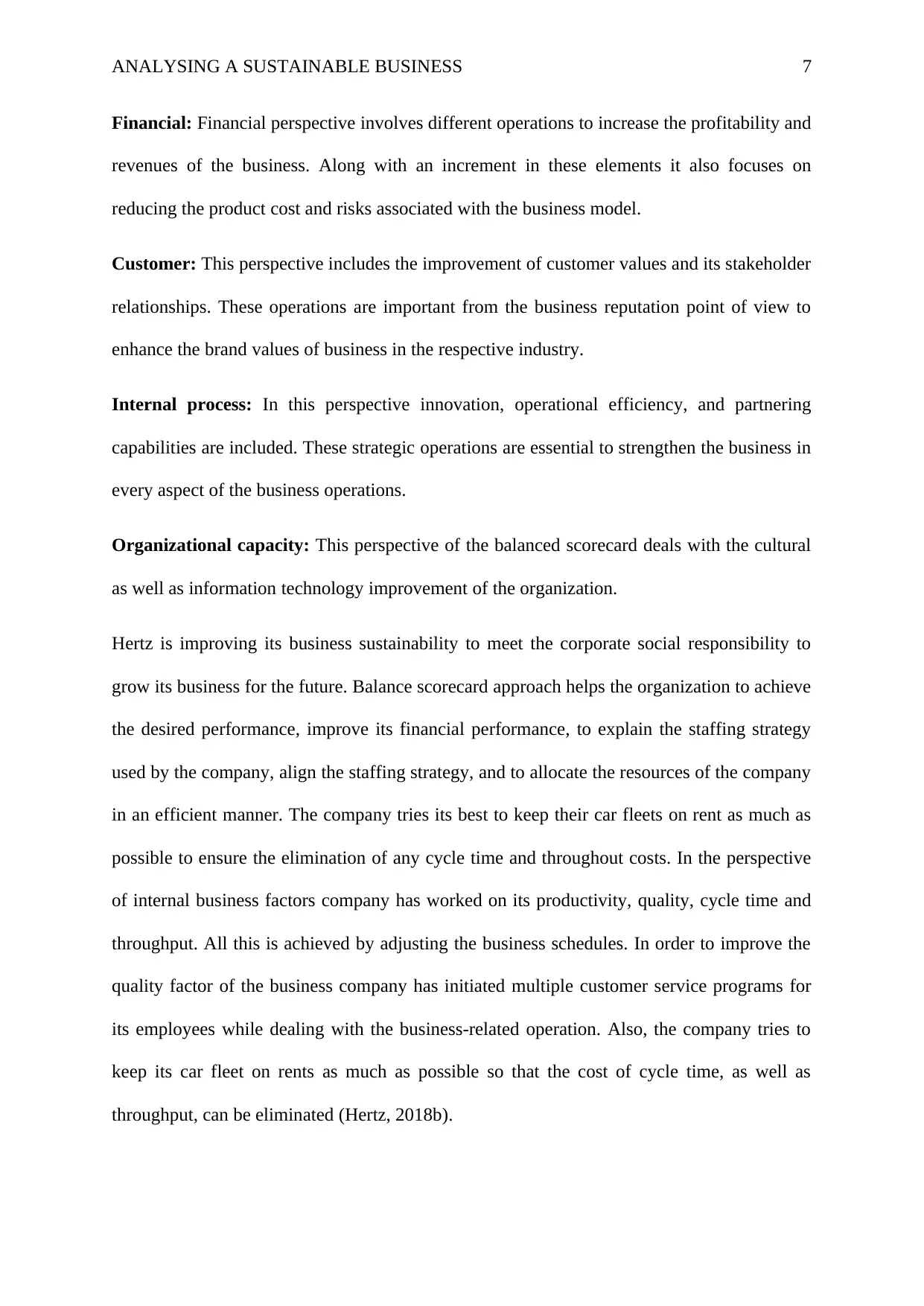
ANALYSING A SUSTAINABLE BUSINESS 7
Financial: Financial perspective involves different operations to increase the profitability and
revenues of the business. Along with an increment in these elements it also focuses on
reducing the product cost and risks associated with the business model.
Customer: This perspective includes the improvement of customer values and its stakeholder
relationships. These operations are important from the business reputation point of view to
enhance the brand values of business in the respective industry.
Internal process: In this perspective innovation, operational efficiency, and partnering
capabilities are included. These strategic operations are essential to strengthen the business in
every aspect of the business operations.
Organizational capacity: This perspective of the balanced scorecard deals with the cultural
as well as information technology improvement of the organization.
Hertz is improving its business sustainability to meet the corporate social responsibility to
grow its business for the future. Balance scorecard approach helps the organization to achieve
the desired performance, improve its financial performance, to explain the staffing strategy
used by the company, align the staffing strategy, and to allocate the resources of the company
in an efficient manner. The company tries its best to keep their car fleets on rent as much as
possible to ensure the elimination of any cycle time and throughout costs. In the perspective
of internal business factors company has worked on its productivity, quality, cycle time and
throughput. All this is achieved by adjusting the business schedules. In order to improve the
quality factor of the business company has initiated multiple customer service programs for
its employees while dealing with the business-related operation. Also, the company tries to
keep its car fleet on rents as much as possible so that the cost of cycle time, as well as
throughput, can be eliminated (Hertz, 2018b).
Financial: Financial perspective involves different operations to increase the profitability and
revenues of the business. Along with an increment in these elements it also focuses on
reducing the product cost and risks associated with the business model.
Customer: This perspective includes the improvement of customer values and its stakeholder
relationships. These operations are important from the business reputation point of view to
enhance the brand values of business in the respective industry.
Internal process: In this perspective innovation, operational efficiency, and partnering
capabilities are included. These strategic operations are essential to strengthen the business in
every aspect of the business operations.
Organizational capacity: This perspective of the balanced scorecard deals with the cultural
as well as information technology improvement of the organization.
Hertz is improving its business sustainability to meet the corporate social responsibility to
grow its business for the future. Balance scorecard approach helps the organization to achieve
the desired performance, improve its financial performance, to explain the staffing strategy
used by the company, align the staffing strategy, and to allocate the resources of the company
in an efficient manner. The company tries its best to keep their car fleets on rent as much as
possible to ensure the elimination of any cycle time and throughout costs. In the perspective
of internal business factors company has worked on its productivity, quality, cycle time and
throughput. All this is achieved by adjusting the business schedules. In order to improve the
quality factor of the business company has initiated multiple customer service programs for
its employees while dealing with the business-related operation. Also, the company tries to
keep its car fleet on rents as much as possible so that the cost of cycle time, as well as
throughput, can be eliminated (Hertz, 2018b).
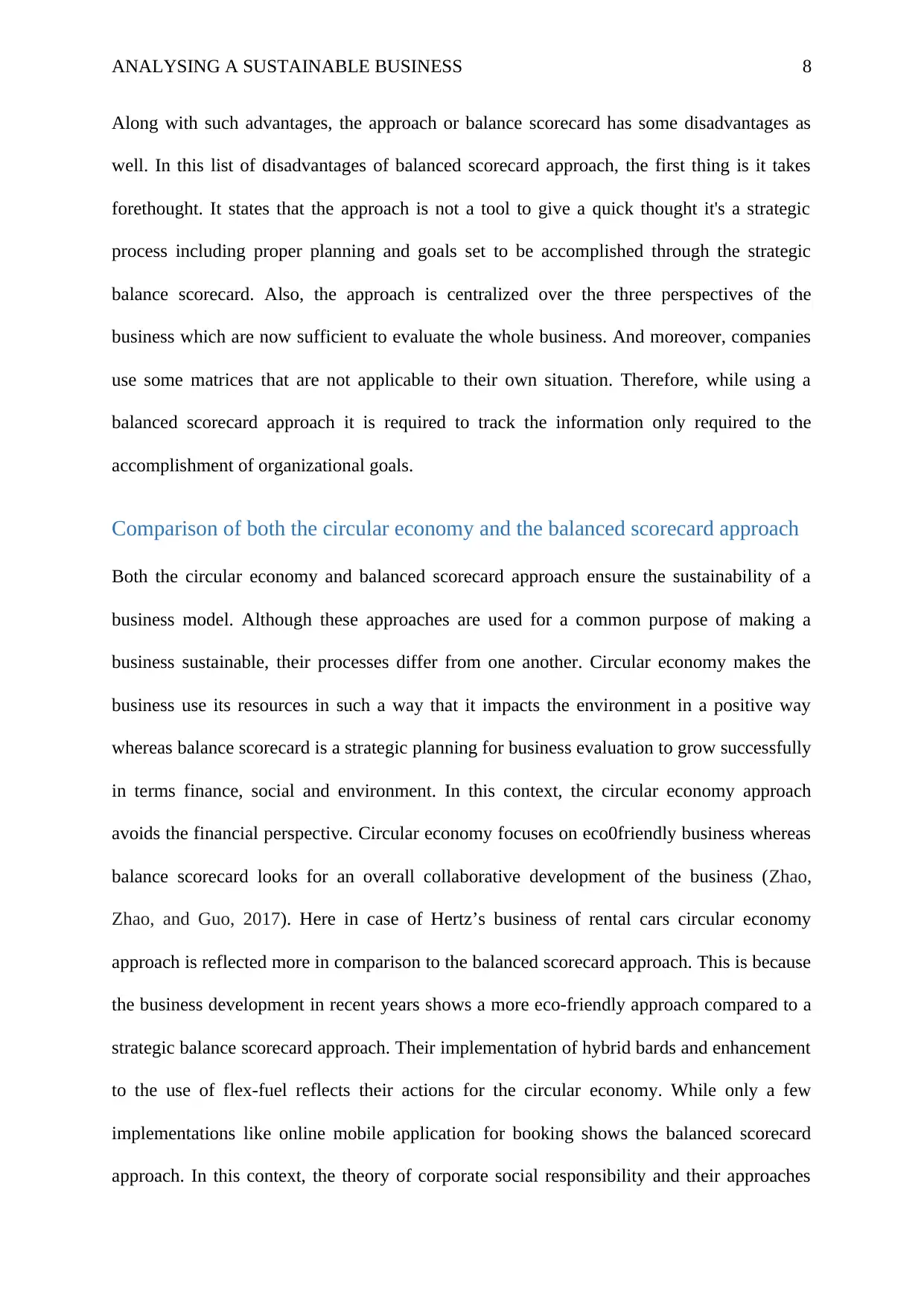
ANALYSING A SUSTAINABLE BUSINESS 8
Along with such advantages, the approach or balance scorecard has some disadvantages as
well. In this list of disadvantages of balanced scorecard approach, the first thing is it takes
forethought. It states that the approach is not a tool to give a quick thought it's a strategic
process including proper planning and goals set to be accomplished through the strategic
balance scorecard. Also, the approach is centralized over the three perspectives of the
business which are now sufficient to evaluate the whole business. And moreover, companies
use some matrices that are not applicable to their own situation. Therefore, while using a
balanced scorecard approach it is required to track the information only required to the
accomplishment of organizational goals.
Comparison of both the circular economy and the balanced scorecard approach
Both the circular economy and balanced scorecard approach ensure the sustainability of a
business model. Although these approaches are used for a common purpose of making a
business sustainable, their processes differ from one another. Circular economy makes the
business use its resources in such a way that it impacts the environment in a positive way
whereas balance scorecard is a strategic planning for business evaluation to grow successfully
in terms finance, social and environment. In this context, the circular economy approach
avoids the financial perspective. Circular economy focuses on eco0friendly business whereas
balance scorecard looks for an overall collaborative development of the business (Zhao,
Zhao, and Guo, 2017). Here in case of Hertz’s business of rental cars circular economy
approach is reflected more in comparison to the balanced scorecard approach. This is because
the business development in recent years shows a more eco-friendly approach compared to a
strategic balance scorecard approach. Their implementation of hybrid bards and enhancement
to the use of flex-fuel reflects their actions for the circular economy. While only a few
implementations like online mobile application for booking shows the balanced scorecard
approach. In this context, the theory of corporate social responsibility and their approaches
Along with such advantages, the approach or balance scorecard has some disadvantages as
well. In this list of disadvantages of balanced scorecard approach, the first thing is it takes
forethought. It states that the approach is not a tool to give a quick thought it's a strategic
process including proper planning and goals set to be accomplished through the strategic
balance scorecard. Also, the approach is centralized over the three perspectives of the
business which are now sufficient to evaluate the whole business. And moreover, companies
use some matrices that are not applicable to their own situation. Therefore, while using a
balanced scorecard approach it is required to track the information only required to the
accomplishment of organizational goals.
Comparison of both the circular economy and the balanced scorecard approach
Both the circular economy and balanced scorecard approach ensure the sustainability of a
business model. Although these approaches are used for a common purpose of making a
business sustainable, their processes differ from one another. Circular economy makes the
business use its resources in such a way that it impacts the environment in a positive way
whereas balance scorecard is a strategic planning for business evaluation to grow successfully
in terms finance, social and environment. In this context, the circular economy approach
avoids the financial perspective. Circular economy focuses on eco0friendly business whereas
balance scorecard looks for an overall collaborative development of the business (Zhao,
Zhao, and Guo, 2017). Here in case of Hertz’s business of rental cars circular economy
approach is reflected more in comparison to the balanced scorecard approach. This is because
the business development in recent years shows a more eco-friendly approach compared to a
strategic balance scorecard approach. Their implementation of hybrid bards and enhancement
to the use of flex-fuel reflects their actions for the circular economy. While only a few
implementations like online mobile application for booking shows the balanced scorecard
approach. In this context, the theory of corporate social responsibility and their approaches
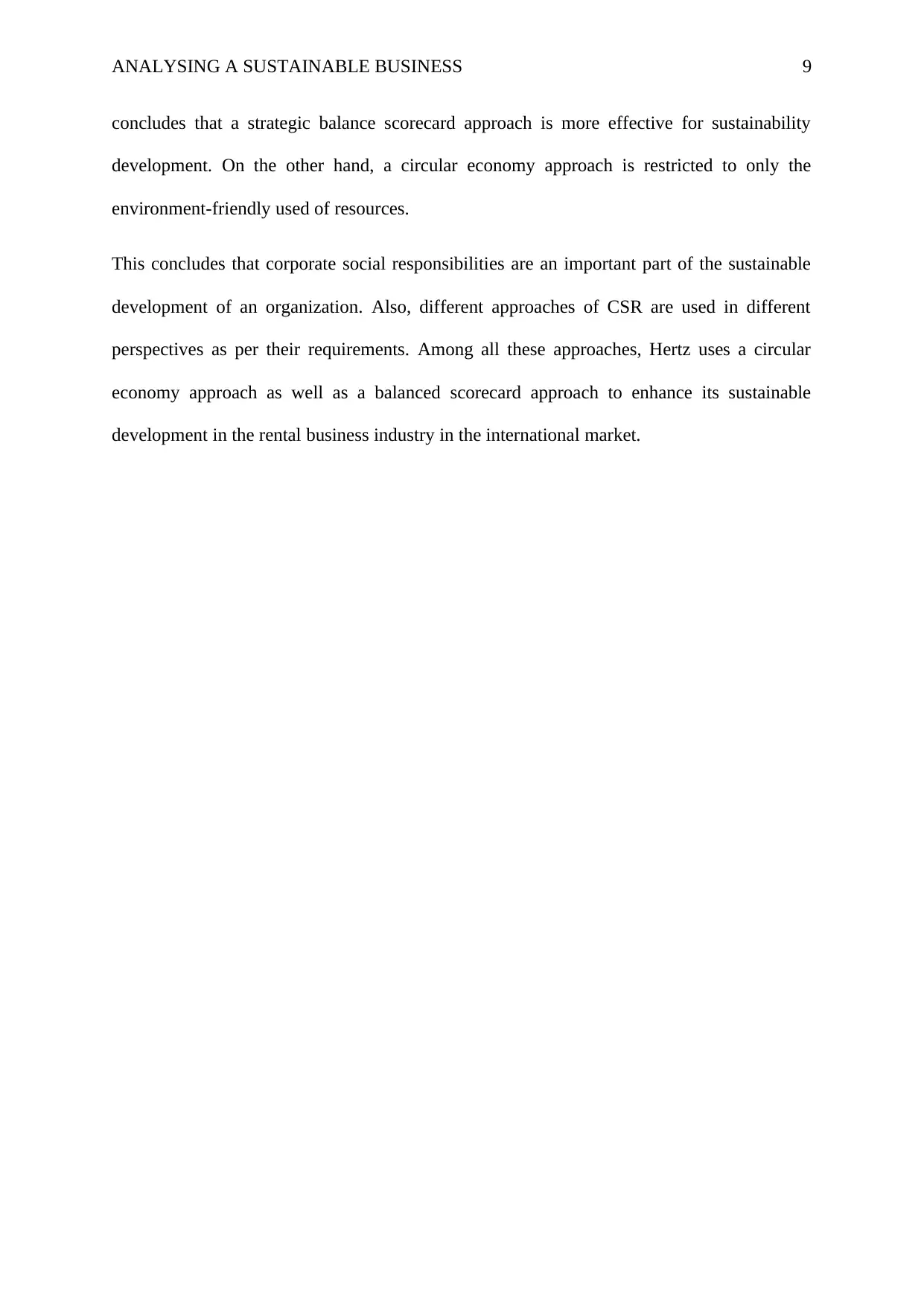
ANALYSING A SUSTAINABLE BUSINESS 9
concludes that a strategic balance scorecard approach is more effective for sustainability
development. On the other hand, a circular economy approach is restricted to only the
environment-friendly used of resources.
This concludes that corporate social responsibilities are an important part of the sustainable
development of an organization. Also, different approaches of CSR are used in different
perspectives as per their requirements. Among all these approaches, Hertz uses a circular
economy approach as well as a balanced scorecard approach to enhance its sustainable
development in the rental business industry in the international market.
concludes that a strategic balance scorecard approach is more effective for sustainability
development. On the other hand, a circular economy approach is restricted to only the
environment-friendly used of resources.
This concludes that corporate social responsibilities are an important part of the sustainable
development of an organization. Also, different approaches of CSR are used in different
perspectives as per their requirements. Among all these approaches, Hertz uses a circular
economy approach as well as a balanced scorecard approach to enhance its sustainable
development in the rental business industry in the international market.
Secure Best Marks with AI Grader
Need help grading? Try our AI Grader for instant feedback on your assignments.
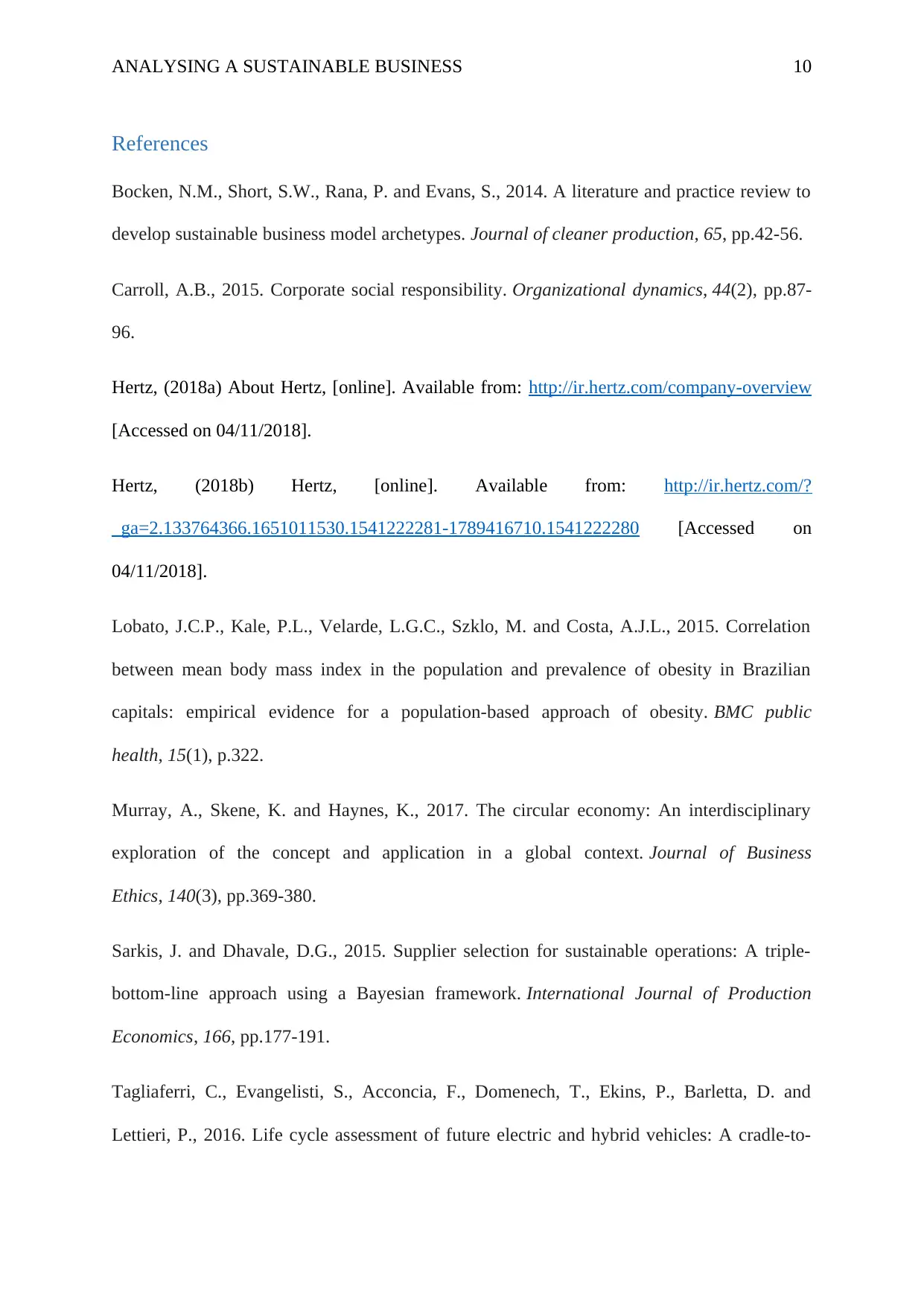
ANALYSING A SUSTAINABLE BUSINESS 10
References
Bocken, N.M., Short, S.W., Rana, P. and Evans, S., 2014. A literature and practice review to
develop sustainable business model archetypes. Journal of cleaner production, 65, pp.42-56.
Carroll, A.B., 2015. Corporate social responsibility. Organizational dynamics, 44(2), pp.87-
96.
Hertz, (2018a) About Hertz, [online]. Available from: http://ir.hertz.com/company-overview
[Accessed on 04/11/2018].
Hertz, (2018b) Hertz, [online]. Available from: http://ir.hertz.com/?
_ga=2.133764366.1651011530.1541222281-1789416710.1541222280 [Accessed on
04/11/2018].
Lobato, J.C.P., Kale, P.L., Velarde, L.G.C., Szklo, M. and Costa, A.J.L., 2015. Correlation
between mean body mass index in the population and prevalence of obesity in Brazilian
capitals: empirical evidence for a population-based approach of obesity. BMC public
health, 15(1), p.322.
Murray, A., Skene, K. and Haynes, K., 2017. The circular economy: An interdisciplinary
exploration of the concept and application in a global context. Journal of Business
Ethics, 140(3), pp.369-380.
Sarkis, J. and Dhavale, D.G., 2015. Supplier selection for sustainable operations: A triple-
bottom-line approach using a Bayesian framework. International Journal of Production
Economics, 166, pp.177-191.
Tagliaferri, C., Evangelisti, S., Acconcia, F., Domenech, T., Ekins, P., Barletta, D. and
Lettieri, P., 2016. Life cycle assessment of future electric and hybrid vehicles: A cradle-to-
References
Bocken, N.M., Short, S.W., Rana, P. and Evans, S., 2014. A literature and practice review to
develop sustainable business model archetypes. Journal of cleaner production, 65, pp.42-56.
Carroll, A.B., 2015. Corporate social responsibility. Organizational dynamics, 44(2), pp.87-
96.
Hertz, (2018a) About Hertz, [online]. Available from: http://ir.hertz.com/company-overview
[Accessed on 04/11/2018].
Hertz, (2018b) Hertz, [online]. Available from: http://ir.hertz.com/?
_ga=2.133764366.1651011530.1541222281-1789416710.1541222280 [Accessed on
04/11/2018].
Lobato, J.C.P., Kale, P.L., Velarde, L.G.C., Szklo, M. and Costa, A.J.L., 2015. Correlation
between mean body mass index in the population and prevalence of obesity in Brazilian
capitals: empirical evidence for a population-based approach of obesity. BMC public
health, 15(1), p.322.
Murray, A., Skene, K. and Haynes, K., 2017. The circular economy: An interdisciplinary
exploration of the concept and application in a global context. Journal of Business
Ethics, 140(3), pp.369-380.
Sarkis, J. and Dhavale, D.G., 2015. Supplier selection for sustainable operations: A triple-
bottom-line approach using a Bayesian framework. International Journal of Production
Economics, 166, pp.177-191.
Tagliaferri, C., Evangelisti, S., Acconcia, F., Domenech, T., Ekins, P., Barletta, D. and
Lettieri, P., 2016. Life cycle assessment of future electric and hybrid vehicles: A cradle-to-
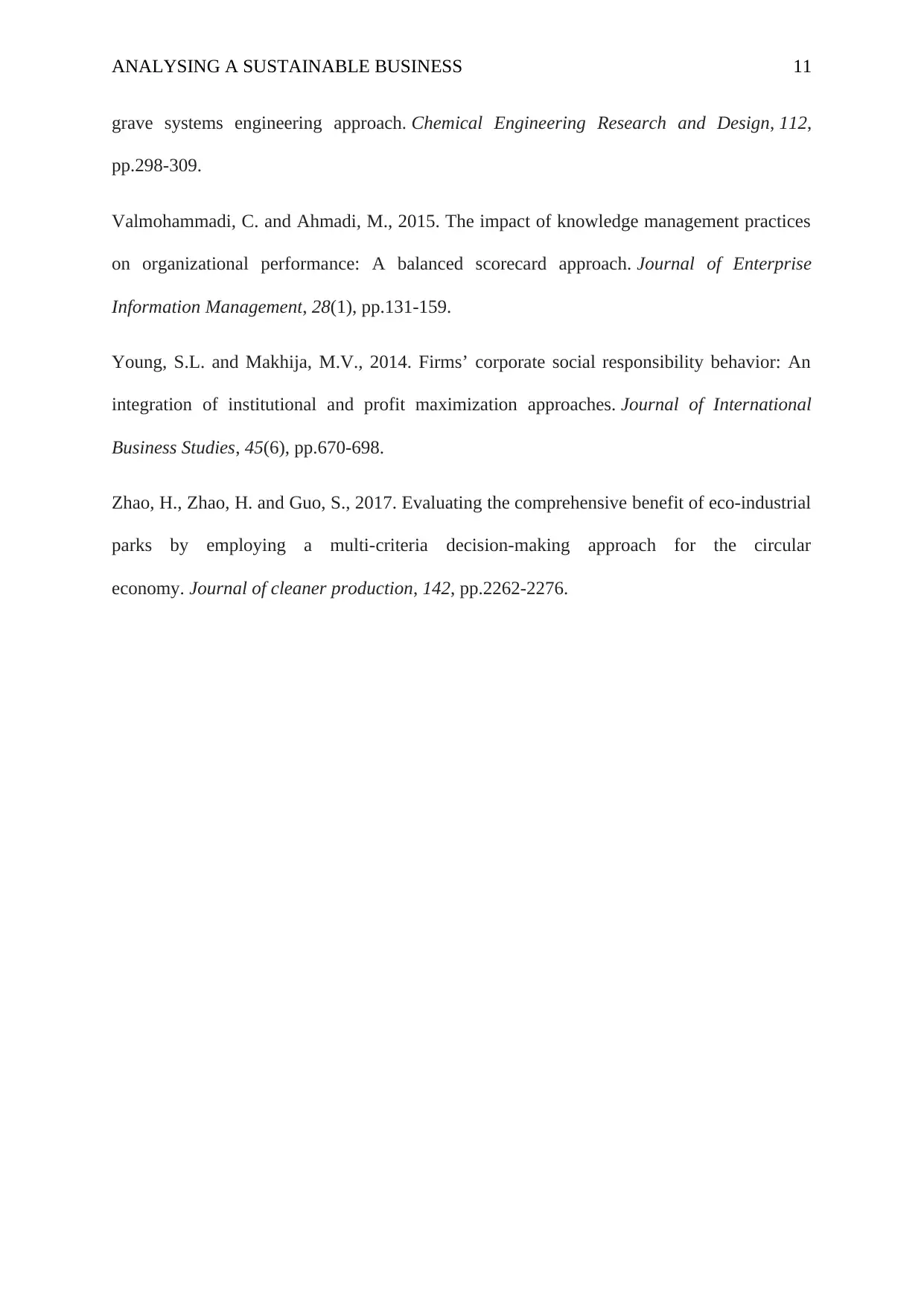
ANALYSING A SUSTAINABLE BUSINESS 11
grave systems engineering approach. Chemical Engineering Research and Design, 112,
pp.298-309.
Valmohammadi, C. and Ahmadi, M., 2015. The impact of knowledge management practices
on organizational performance: A balanced scorecard approach. Journal of Enterprise
Information Management, 28(1), pp.131-159.
Young, S.L. and Makhija, M.V., 2014. Firms’ corporate social responsibility behavior: An
integration of institutional and profit maximization approaches. Journal of International
Business Studies, 45(6), pp.670-698.
Zhao, H., Zhao, H. and Guo, S., 2017. Evaluating the comprehensive benefit of eco-industrial
parks by employing a multi-criteria decision-making approach for the circular
economy. Journal of cleaner production, 142, pp.2262-2276.
grave systems engineering approach. Chemical Engineering Research and Design, 112,
pp.298-309.
Valmohammadi, C. and Ahmadi, M., 2015. The impact of knowledge management practices
on organizational performance: A balanced scorecard approach. Journal of Enterprise
Information Management, 28(1), pp.131-159.
Young, S.L. and Makhija, M.V., 2014. Firms’ corporate social responsibility behavior: An
integration of institutional and profit maximization approaches. Journal of International
Business Studies, 45(6), pp.670-698.
Zhao, H., Zhao, H. and Guo, S., 2017. Evaluating the comprehensive benefit of eco-industrial
parks by employing a multi-criteria decision-making approach for the circular
economy. Journal of cleaner production, 142, pp.2262-2276.
1 out of 12
Related Documents
Your All-in-One AI-Powered Toolkit for Academic Success.
+13062052269
info@desklib.com
Available 24*7 on WhatsApp / Email
![[object Object]](/_next/static/media/star-bottom.7253800d.svg)
Unlock your academic potential
© 2024 | Zucol Services PVT LTD | All rights reserved.




